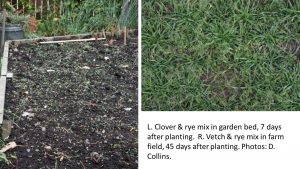Fertilizers (sources of fertility)
Soil Fertility in Organic Systems: A Guide for Gardeners and Small Acreage Farmers, 2013, Pacific Northwest Publication, by Doug Collins, Carol Miles, Craig Cogger, and Richard Koenig. Plant growth is affected by numerous factors, including climate, pest pressure, and nutrient availability. As plants grow, they rely on their roots to provide structural support, water, and nutrients. The right nutrients are essential for growing healthy, productive plants. Well–managed, fertile soils can supply plants with all the nutrients they need. Managing soil fertility requires attention to the source, timing, rate, and placement of nutrient applications.
A Home Gardener’s Guide to Soils and Fertilizers, 2014, Washington State University, by Craig Cogger. This publication describes soil physical and chemical properties and the need for fertilizers. Both certified organic and non-certified organic fertilizers are described.
Lime
Applying Lime to Raise Soil pH for Crop Production (Western Oregon), 2013, Oregon State University Extension, by Nicole Anderson, John Hart, Dan Sullivan, N. Christensen, D. Horneck, and G. Pirelli. This publication describes soil acidity, liming materials, and walks the reader through liming decisions based on soil test information, including buffer pH.
Manure/compost/compost tea/compost systems
Fertilizing with Biosolids, 2015, Pacific Northwest Extension Publication, by Dan Sullivan, Craig Cogger, and Andy Bary. Biosolids are a product of municipal wastewater treatment. Raw sewage solids must be processed to meet U.S. Environmental Protection Agency (USEPA) standards before they can be called biosolids. Biosolids contain organic matter and nutrients that are beneficial for soil, crop, and livestock productivity. This publication focuses on how biosolids can be used to supply nutrients for crop production.
Cover crops
 Cover crops improve soil quality, protect soil, smother weeds, take up excess nutrients from the soil, and legumes add nitrogen.
Cover crops improve soil quality, protect soil, smother weeds, take up excess nutrients from the soil, and legumes add nitrogen.
Leguminous cover crops also increase plant available nitrogen. Oftentimes legumes, such as clover or vetch, are mixed with annual grains like cereal rye. These photos show fall plantings at 7 days and 45 days after seeding. Vetch can provide about 2 lbs plant available nitrogen per 1000 ft2 (80 lbs/acre) in the year that it is incorporated.
In addition to providing nitrogen, cover crops can compete with weeds and protect the soil for pounding rains. Non-leguminous cover crops do not add nitrogen, but they can take up excess nitrogen and other nutrients and help carry those over to the next season- preventing them from leaching.
Cover Crops for Home Gardens – East of the Cascades. 2014. Washington State University Extension Publication FS117E. by, Craig Cogger, Chris Benedict, Nick Andrews, Steve Fransen, and Andy McGuire.
Cover Crops for Home Gardens – West of the Cascades. 2014. Washington State University Extension Publication FS111E. . by, Craig Cogger, Chris Benedict, Nick Andrews, and Andy McGuire.